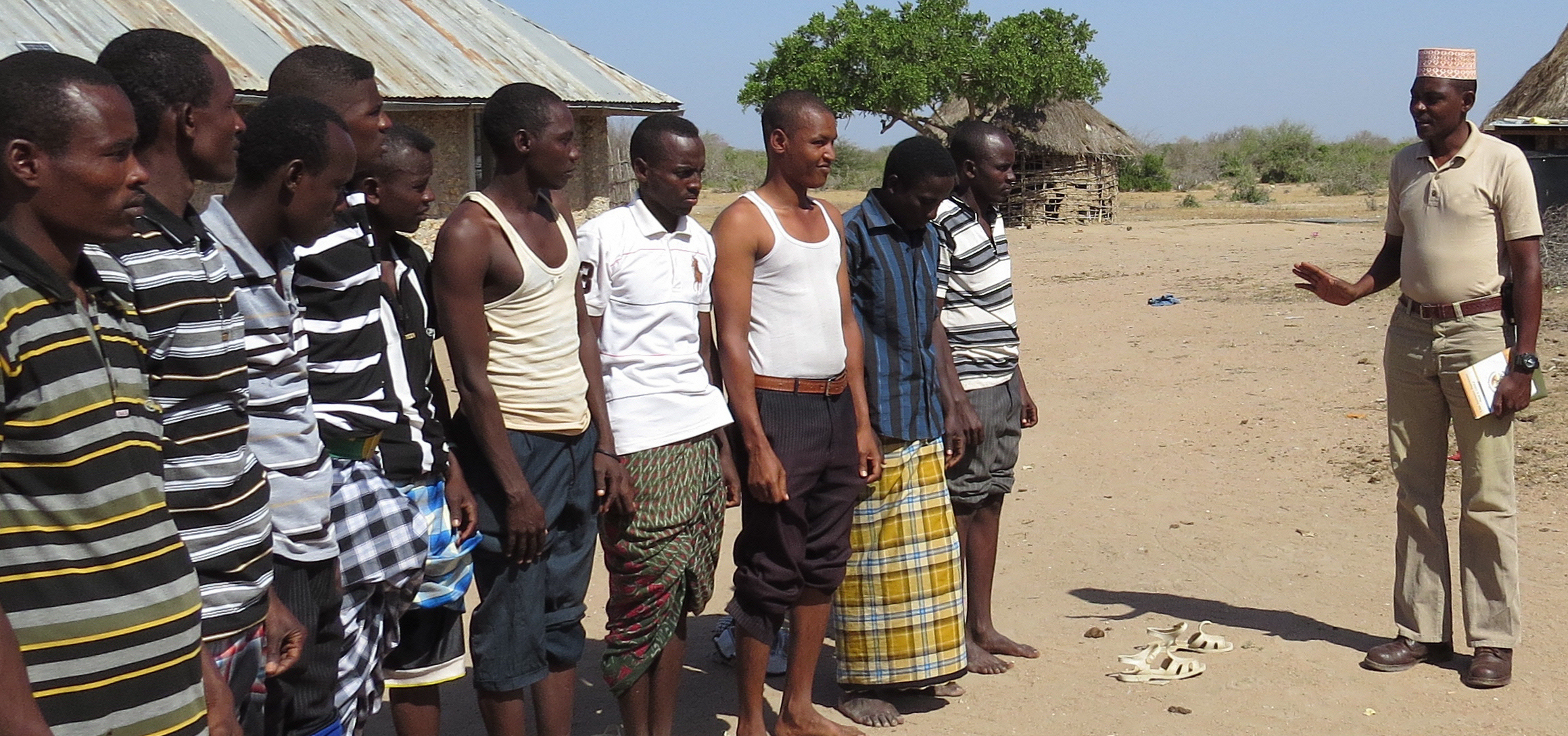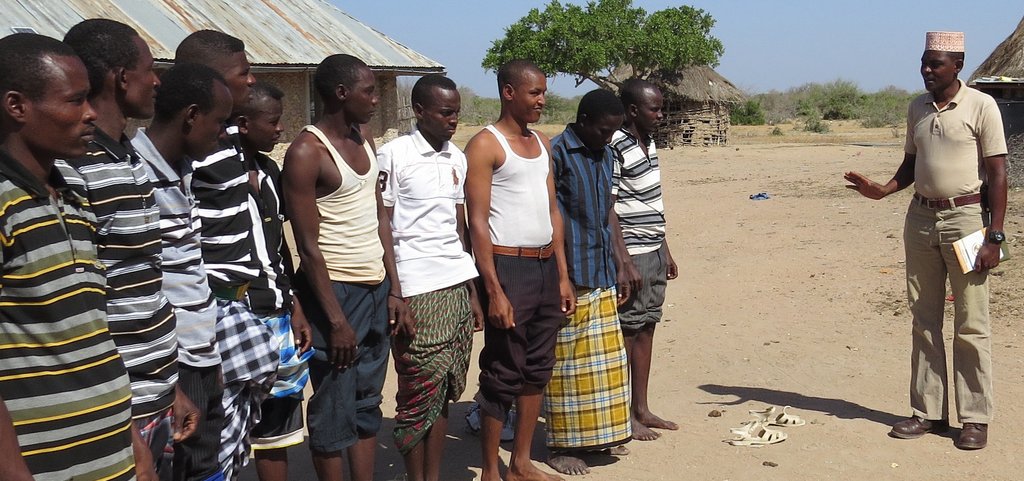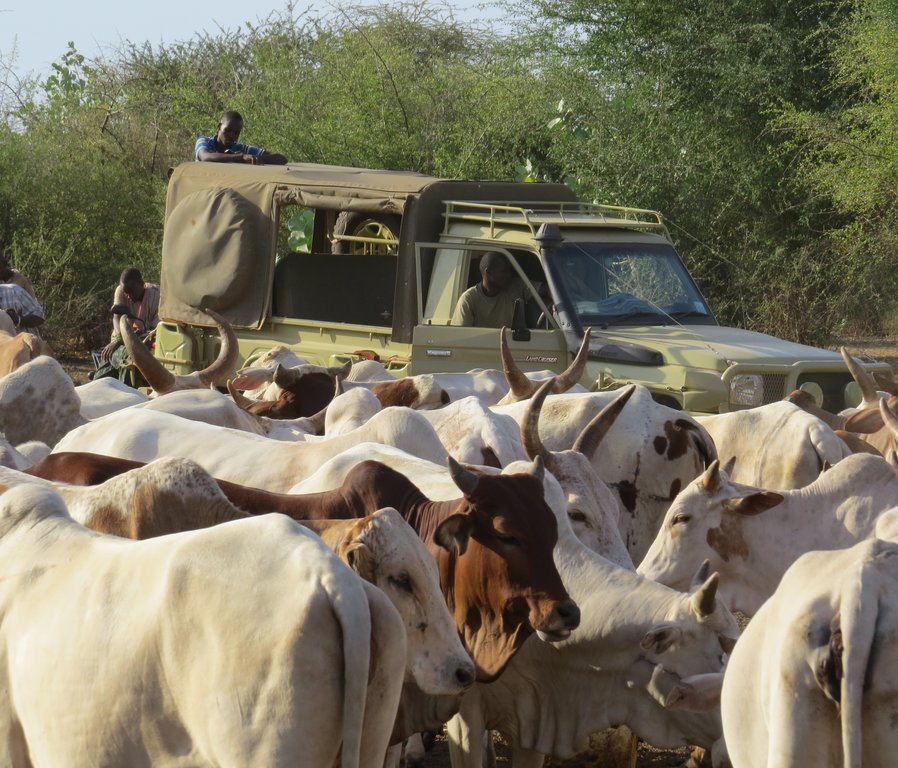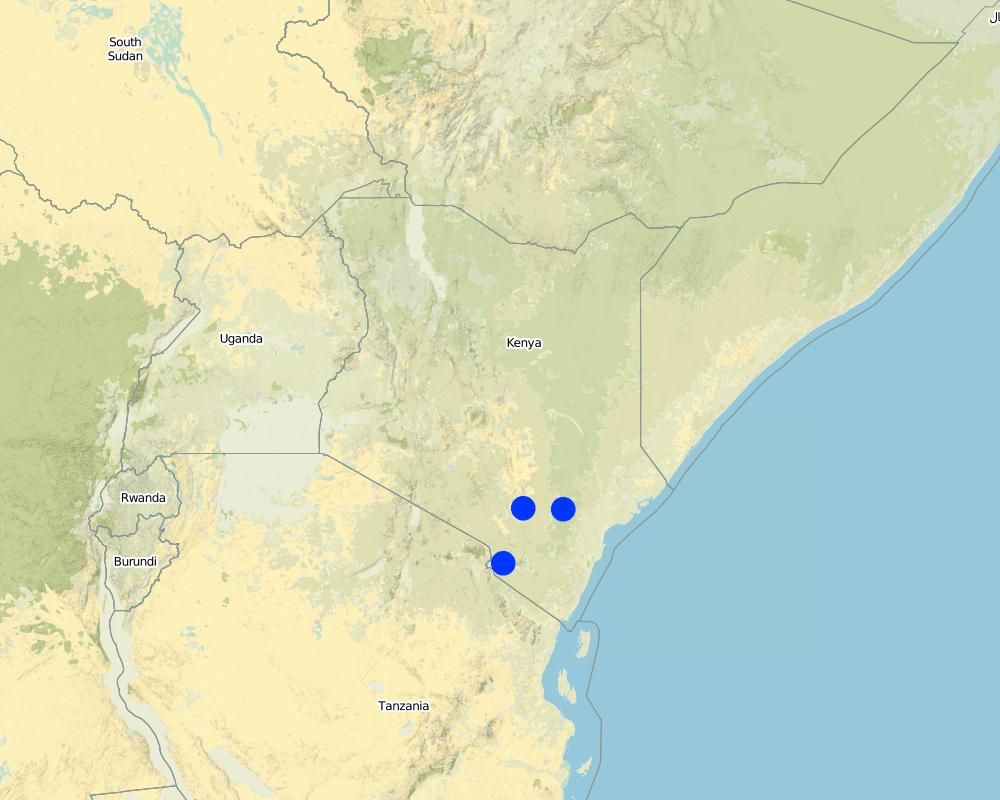Stabilization Through Conservation ('StabilCon') approach [肯尼亚]
- 创建:
- 更新:
- 编制者: Harry Wells
- 编辑者: –
- 审查者: Rima Mekdaschi Studer, Hanspeter Liniger, Donia Mühlematter
approaches_3615 - 肯尼亚
查看章节
全部展开 全部收起1. 一般信息
1.2 参与方法评估和文件编制的资源人员和机构的联系方式
关键资源人员
Protected Area Manager:
1.3 关于使用通过WOCAT记录的数据的条件
(现场)数据是什么时候汇编的?:
16/04/2018
编制者和关键资源人员接受有关使用通过WOCAT记录数据的条件。:
是
2. SLM方法的描述
2.1 该方法的简要说明
The 'StabilCon' approach is a non-aggressive, low-intensity stabilization model that seeks to reconcile the needs of both humans and their natural environment. To achieve this, StabilCon aims to co-develop two mutually beneficial elements: sustainable natural resource management and human security in rural areas.
2.2 该方法的详细说明
该方法的详细说明:
StabilCon is a holistic approach that seeks to develop social-ecosystems that accept wildlife and respect natural resources, in order to address complex conservation challenges. Implemented by rural communities, in partnership with local stewardship organizations, such as Tsavo Conservation Group, StabilCon aims to build human and natural resource security. StabilCon also aims to shift the human-wildlife relationship from conflict towards a symbiotic relationship with mutual benefits. The approach is based on the premise that unstable environments (whether due to human, economic or environmental factors) preclude any conservation, sustainable development or natural resource management initiative. Therefore, StabilCon seeks to build institutional capacity in rural communities to achieve four interrelated goals: 1) Support the rule of law (e.g. through training of community rangers) to reduce physical insecurity for humans, wildlife and natural resources to manageable levels as a mandatory first step; 2) Use this security as a foundation on which to build and diversify nature-based economic opportunities (e.g. reduced wildlife poaching facilitates the development of tourism-based economic opportunities, while greater local security can also benefit livestock-keeping by reducing the incidents of stock thefts); 3) Strengthen environmental security to enable benefits of biodiversity conservation and healthy ecosystems to be shared by current and future generations; 4) Develop more robust, equitable and representative community governance system, aligned with county and national government agencies and their objectives (e.g. through governance training within rural communities).
StabilCon aims to use these four interrelated goals to develop a foundation of long-term environmental security and create circumstances conducive to socio-economic progress of rural communities. Activities are conducted by the StabilCon Implementation Unit (SIU), which in the Tsavo Model is composed of 5 members: 1) CEO & co-founder of Tsavo Conservation Group (TsavoCon) - responsibilities include managing TsavoCon's strategic direction through StabilCon, developing & managing strategic relationships, working with Kenya's national and county governments and US government, international fund raising; 2) TsavoCon Chief Financial Officer - Taita Taveta born and a member of the Association of Chartered Accountants (London) who leads human resources issues and is responsible for financial operations (e.g. opening bank accounts for full time staff, introducing and managing accounting software); 3) Operations Officer - supports CEO in developing strategic relationships (e.g. liaison with Taita Conservancy elders, county government officials, NGO partners) and is a Geographic Information System analyst developing a map database (e.g. elephant poaching data); 4) Liaison Officer - responsible for engagement with Orma community members of Malkahalaku Community Conservancy as well as liaison with local and national government officials, and to manage the conservancy's rangers (he was formerly an instructor with the Kenya Wildlife Service); 5) TsavoCon Pilot - responsibilities include managing aerial observation operations, TsavoCon vehicles, communications, resupply & logistics of TsavoCon assets in the field.
2.3 该方法的照片
2.5 采用该方法的国家/地区/地点
国家:
肯尼亚
有关地点的进一步说明:
Greater Tsavo Ecosystem
注释:
For more details see: http://www.tsavocon.org/
Map
×2.6 该方法的开始和终止日期
注明开始年份:
2016
若不知道准确的年份,请注明该方法的大致开始日期。:
不到10年前(最近)
2.7 方法的类型
- 最近的本地倡议/创新
2.8 该方法的主要目的/目标
StabilCon seeks to build institutional capacity in rural communities to achieve four interrelated goals:
1) Effective security, law and order - Support the rule of law to reduce physical insecurity for humans, wildlife and natural resources to manageable levels as a mandatory first step to enable the other three goals;
2) Economic security - Use this security as a foundation on which to build and diversify nature-based economic opportunities (e.g. livestock and tourism);
3) Environmental security - Strengthen environmental security to enable benefits of biodiversity conservation and healthy ecosystems to be shared by current and future generations;
4) Social security - Develop more robust, equitable and representative community governance system, aligned with county and national government agencies and their objectives.
2.9 推动或妨碍实施本办法所适用的技术的条件
社会/文化/宗教规范和价值观
- 启动
Livestock, water and security are already top priorities for local communities and are in alignment with StabilCon's objectives.
- 阻碍
Rural communities, limited in their access to education, find it difficult to navigate the bureaucratic processes involved in securing funding.
财务资源和服务的可用性/可得性
- 启动
USAID and other donors assist greatly by funding StabilCon's activities.
参与者的的协作/协调
- 启动
The improved relationship between the Malkahalaku community and the Kenya Wildlife Service (national government), facilitated by StabilCon's Implementation Unit (SIU), has been beneficial particularly in conflict mitigation.
- 阻碍
Dysfunctional relationships among local chiefs and between Malkahalau community and the Kenya Wildlife Service (KWS) were initially hindering. In addition, almost every year, heightened competition over fodder/water for livestock between pastoralists and agriculturalists and between neighbouring pastoral communities lead to conflicts, which are often violent. Previously, the dysfunctional relationship between Malkahalaku community and KWS led to confrontations and destruction of KWS infrastructure. On one occasion, KWS rangers posted in the community were chased out by community members and the KWS ranger post burnt down by community members.
法律框架(土地使用权、土地和水使用权)
- 启动
The official conservancy status given when the Malkahalaku Community Conservancy was established in 2015 was crucial in providing land tenure security. This stronger land tenure security has been instrumental in NRM through resolving conflicts with neighbouring communities over access to grazing/water.
政策
- 启动
The Wildlife Act has been particularly beneficial through its support of conservation activities. The Act emphasises effective public participation in the management of wildlife resources, thereby setting a basis for the strengthening of community based NRM.
土地治理(决策、实施和执行)
- 阻碍
Poor law enforcement in rural areas leads to social insecurity at the community level. This impacts many aspects of NRM including illegal wildlife poaching and armed conflicts between pastoralist groups over access to grazing/water.
了解SLM,获得技术支持
- 启动
StabilCon aims to integrate the extensive local knowledge relating to pastoralism among Oromo people. However, traditional livestock management practices are also evolving and the Oromo are moving towards reducing livestock numbers and raising livestock quality (similar to the ranching approach).
- 阻碍
Some previous local pastoral practices are no longer applicable to the changing environment, particularly with regard to quality and number of livestock, but practices are changing. For example, the shift from emphasis on the number of livestock owned towards smaller herd sizes and higher quality livestock.
市场(购买投入,销售产品)和价格
- 阻碍
Importing meat from neighbouring countries (e.g. Tanzania, Uganda) floods Kenya's market, leading to a poor economic environment for local livestock production. StabilCon is currently planning to improve Malkahalaku Community Conservancy's access to national beef markets that will provide more favourable prices for the community's members.
工作量、人力资源可用性
- 阻碍
StabilCon has a small team, but their dedication helps compensate for the limited man hours.
其他
- 阻碍
Social insecurity is one of the main barriers and it is exacerbated by climatic changes. More specifically, shifts in patterns and temporal distribution of rainfall pose challenges even for highly mobile pastoralists. During drought periods, heightened competition over grazing and water intensify human conflict. These conflicts over basic resources preclude NRM activities.
3. 相关利益相关者的参与和角色
3.1 该方法涉及的利益相关者及其职责
- 当地土地使用者/当地社区
Taita Taveta Wildlife Conservancies Association and Malkahalaku Community Conservancy.
In the Taita area, Taita Taveta Wildlife Conservancies Association is the main local institutional actor, as it represents all 28 conservancies in the area (a large number of community members sign up to be part of one or more conservancies). In the Tana River County area, Malkahalaku Community Conservancy is the main institutional actor.
- SLM专家/农业顾问
Tsavo Conservation Group (TsavoCon). TsavoCon is composed of four members: CEO (an experienced protected area manager and leader of international relations; degree in Wildlife Conservation Management), Tana River County Coordinator (paramilitary-trained with experienced in wildlife conservation/anti-poaching; diploma in Wildlife Sanctuary Management), Taita Taveta County Coordinator (experienced wildlife conservationist and former CEO of Taita Taveta Wildlife Conservancies), Chief Financial Officer (experienced in conservation-focused non-profit management).
In the Tsavo Model of StabilCon, TsavoCon is the main facilitating organization, providing a link between local communities, livestock and rangeland management experts and international funding organisations. TsavoCon acts as the StabilCon Implementation Unit (SIU) in the Greater Tsavo Ecosystem.
- 研究人员
Geographic Information System specialist.
This researcher compiles data collected by StabilCon on poaching and insecurity. Tracking trends in elephant poaching as an indicator of increased security is one of the ways in which these data are used.
- NGO
Global Environmental Facility, African Wildlife Foundation, Wildlife Works.
These NGO's fund StabilCon's activities and/or act as conservation partners of Tsavo Conservation Group.
- 地方政府
These include: the county environmental minister and their department; the county minister of lands; the county minister of livestock; the chairman of conservation compensation committee.
These actors are involved in allocation of local government support for community-level projects.
- 国家政府(规划者、决策者)
Kenya Wildlife Service (KWS), County Security Committee (national security apparatus)
These actors are mandated national security agencies. KWS's Law Enforcement Academy trained 22 members of Malkahalaku Community Conservancy (funded by Tsavo Conservation Group), who are now rangers for the conservancy. These rangers patrol their conservancy, increasing human security and reducing poaching. During droughts, KWS allow Malkahalaku Community Conservancy livestock to graze in Tsavo East National Park to relieve pressure on the community and diffuse conflicts over fodder/water. In Kenya, this is a relatively common but controversial practice as it puts pressure on the land within the protected area and potentially increases herd sizes and overall grazing pressure, particularly over the long term.
- 国际组织
USAID, Global Environment Facility, African Wildlife Foundation, Wildlife Works
Funding and/or Tsavo Conservation Group conservation partners.
如果涉及多个利益相关者,请注明领导机构:
In the Tsavo model of StabilCon, Tsavo Conservation Group fulfils the role of StabilCon Implementation Unit (SIU), and is the lead facilitator and coordinator in the Greater Tsavo Ecosystem.
3.2 当地土地使用者/当地社区参与该方法的不同阶段
| 当地土地使用者/当地社区的参与 | 指定参与人员并描述活动 | |
|---|---|---|
| 启动/动机 | 互动 | Under the StabilCon approach, international and local actors are involved in the initiation phase but it leads towards self mobilization. |
| 计划 | 互动 | The StabilCon Implementation Unit (composed of a coordinator, experts/professionals and local actors) leads the planning phase, which includes an area identification and a ground feasibility study. |
| 实施 | 自我动员 | All activities are implemented by local communities. |
| 监测/评估 | 外部支持 | Data is mainly collected and analyzed by specialists/experts. |
3.3 流程图(如可用)
3.4 有关SLM技术选择的决策
具体说明谁有权决定选择要实施的技术:
- 主要是土地使用者,由SLM专家提供支持
解释:
StabilCon aims to bring together international SLM experience with local SLM knowledge to develop activities.
明确做出决策的依据:
- 对充分记录的SLM知识进行评估(基于证据的决策)
- 个人经验和意见(无记录)
4. 技术支持、能力建设和知识管理
4.1 能力建设/培训
是否为土地使用者/其他利益相关者提供培训?:
是
明确受训人员:
- 土地使用者
- local government (e.g. accounting, legal, economic)
培训形式:
- 在职
- 课程
涵盖的主题:
22 members of the Malkahalaku Community Conservancy were trained through a Kenya Wildlife Service Law Enforcement Academy programme, to enable them to serve as rangers for their conservancy to improve local security. The StabilCon implementation Unit also conducted courses to train the Conservancy's management and employees in various offices (e.g. accounting, legal, economic) to improve governance in Malkahalaku Community Conservancy.
4.2 咨询服务
土地使用者有权使用咨询服务吗?:
是
- Depends on who is receiving the advice.
说明/注释:
StabilCon Implementation Unit (SIU) provides advice to individuals at multiple levels from government to local.
4.3 机构强化(组织发展)
是否通过这种方法建立或加强了机构?:
- 是,非常
具体说明机构的强化或建立程度:
- 本地
- 区域
- 国家
说明机构、角色和职责、成员等。:
Tsavo Conservation Group, as the StabilCon Implementation Unit (SIU), liaise with all stakeholders to develop an integrated landscape security model in Taita
具体说明支持类型:
- 财务
- 能力建设/培训
提供进一步细节:
The Kenya Wildlife Service is due to train 40 Taita community rangers at their Law Enforcement Academy, funded by USAID in conjunction with Tsavo Conservation Group.
4.4 监测和评估
监测和评估是该方法的一部分吗?:
否
注释:
The StabilCon approach relies on accurate data to inform decision making. Tsavo Conservation Group maintains a rigorous monitoring and evaluation procedure and maps human-wildlife conflict and rural human dynamics affecting the natural environment in its focal area.
4.5 研究
研究是该方法的一部分吗?
否
5. 融资和外部物质支持
5.1 该方法中SLM组成部分的年度预算
如果不知道准确的年度预算,请给出一个范围:
- 100,000-1,000,000
注释(例如主要的资助来源/主要捐助者):
USAID and private donors are the main funding sources.
5.2 为土地使用者提供财政/物质支援
土地使用者是否获得实施该技术的财政/物质支持?:
是
如果是,请具体说明支持的类型、条件和提供者:
Tsavo Conservation Group raises external funding for rangers (training, salaries etc.), security infrastructure (buildings, vehicles etc.); logistics, planning and deployment costs. However, the StabilCon approach aims to make all activities economically self-sustaining through internal funding.
5.3 对特定投入的补贴(包括劳动力)
- 无
如果土地使用者的劳动力是一项重要的投入,那么是不是:
- 以现金支付
注释:
Conservancy rangers are paid in cash through StabilCon, but these costs will gradually be internalized.
5.4 信用
是否根据SLM活动的方法给予信用值?:
否
5.5 其它激励或手段
是否有其他激励措施或工具用于促进SLM技术的实施?:
否
6. 影响分析和结论性陈述
6.1 方法的影响
该方法是否有助于当地土地使用者,提高利益相关者的参与度?:
- 否
- 是,很少
- 是,中等
- 是,支持力度很大
The training of community conservancy rangers enables the conservancies to increase the degree to which they manage their own security, and are less dependent on already overstretched government law enforcement agencies.
该方法是否帮助土地使用者实施和维护SLM技术?:
- 否
- 是,很少
- 是,中等
- 是,支持力度很大
Data collected thus far indicates that elephant poaching has declined considerably since StabilCon's implementation, but it is not yet possible to gauge the sustainability due to the short duration of operation.
该方法是否提高了SLM的协调性和成本效益?:
- 否
- 是,很少
- 是,中等
- 是,支持力度很大
By acting as an impartial arbitrator, the StabilCon Implementation Unit facilitated coordination between chiefs who previously had dysfunctional relationships.
该方法是否调动/改善了使用财务资源实施SLM的途径?:
- 否
- 是,很少
- 是,中等
- 是,支持力度很大
StabilCon raised funding from international organizations such as USAID, that would otherwise have been inaccessible to local people.
该方法是否提高了其他利益相关者的知识和能力?:
- 否
- 是,很少
- 是,中等
- 是,支持力度很大
Capacity building was provided to local government employees (e.g. accountants, legal, economic). It was also provided to conservancy members in the form of ranger training.
该方法是否建立/加强了机构、利益相关者之间的合作?:
- 否
- 是,很少
- 是,中等
- 是,支持力度很大
StabilCon facilitated collaboration among actors who previously did not coordinate at local-level (chiefs) and government-level (government departments).
该方法是否缓解了冲突?:
- 否
- 是,很少
- 是,中等
- 是,支持力度很大
The StabilCon Implementation Unit helped mitigate conflicts between Malkahalaku Community members and the Kenya Wildlife Service (national government) by facilitating dialogue and acting as third party mediators.
该方法是否带来了更可持续的能源使用?:
- 否
- 是,很少
- 是,中等
- 是,支持力度很大
No energy source dimension to the approach.
该方法是否提高了土地使用者适应气候变化/极端情况和减轻气候相关灾害的能力?:
- 否
- 是,很少
- 是,中等
- 是,支持力度很大
As StabilCon has only been active for 3 years this is difficult to judge.
该方法是否会带来就业、收入机会?:
- 否
- 是,很少
- 是,中等
- 是,支持力度很大
StabilCon created job opportunities relating to conservancy security (mainly rangers).
6.2 土地使用者实施SLM的主要动机
- 增加利润(能力),提高成本效益比
Wealth and a better life are the main motivations for all activities.
- 规章制度(罚款)/执行
Law enforcement at the community level in rural communities is one of the main benefits of formally trained conservancy rangers.
- 冲突缓解
Conflict mitigation is a significant aspect of this approach. The presence of formally trained rangers benefits community members in the form of improved social security and possibly economic opportunities (e.g. less wildlife poaching may improve tourism and fewer stock thefts may facilitate livestock-keeping).
6.3 方法活动的可持续性
土地使用者能否维持通过该方法实施的措施(无外部支持的情况下)?:
- 不确定
若否或不确定,请具体说明并予以注释:
StabilCon has only been active for 3 years so this is difficult to gauge.
6.4 该方法的长处/优点
| 土地使用者眼中的长处/优势/机会 |
|---|
| Due to StabilCon's structured approach, it can be budgeted in the long term. |
| StabilCon requires minimal intervention and relies mainly on internal motivation and activity. |
| The long-term aim is for revenue to be generated internally and sustainably through a structured investment model. |
| 编制者或其他关键资源人员认为的长处/优势/机会 |
|---|
| Enables local communities to access international funds. |
| The StabilCon approach seeks to leverage the interaction between SLM and human security. |
| Integration of international SLM experience with local knowledge. |
| The StabilCon approach seeks to identify the extraordinary in people and nurture their strengths |
6.5 该方法的弱点/缺点以及克服它们的方法
| 土地使用者认为的弱点/缺点/风险 | 如何克服它们? |
|---|---|
| The need to raise start-up funding. | Ensure adequate focus on fund-raising. |
| StabilCon is not a stand-alone 'silver bullet', but needs a certain amount of national infrastructure in place in order to operate. | None. |
| StabilCon depends heavily on the individuals employed and can thus be impacted considerably by the human weaknesses of individuals. | Over the long-term, educate people to develop interdisciplinary skills. |
| 编制者或其他关键资源人员认为的弱点/缺点/风险 | 如何克服它们? |
|---|---|
| With few years of active experience of StabilCon, the benefits, downfalls and sustainability of the approach are still unclear. | Continuation of the approach will reveal its strengths and weaknesses. |
7. 参考和链接
7.1 方法/信息来源
- 与SLM专业人员/专家的访谈
One expert (co-founder & CEO of Tsavo Conservation Group and the StabilCon approach)
- 根据报告和其他现有文档进行编译
Reports and documentation shared by the informant and project websites.
7.2 参考可用出版物
标题、作者、年份、ISBN:
Saunders I, Saunders T (2017) The StabilCon Brief
可以从哪里获得?成本如何?
Freely available an in the public domain
7.3 链接到网络上可用的相关信息
标题/说明:
Stabilization Through Conservation (StabilCon) on Tsavo Conservation Group website
URL:
http://www.tsavocon.org/stabilcon/
标题/说明:
Tsavo Conservation Group's eMAP (Elephant Monitoring and Anti-Poaching) project
链接和模块
全部展开 全部收起链接
无链接
模块
无模块






